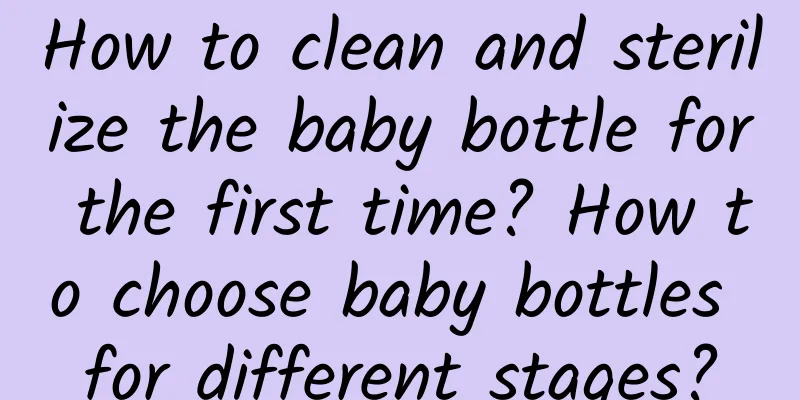How to clean and sterilize the baby bottle for the first time? How to choose baby bottles for different stages?

|
A milk bottle is a container for milk, usually for babies. The milk bottle itself does not include a nipple, but only the bottle body. However, manufacturers of baby milk bottles usually give a nipple with the bottle. So how do you clean and disinfect the milk bottle for the first time? How do you choose milk bottles for babies at different stages? Let's take a look at the introduction of Encyclopedia Knowledge Network below! Contents of this article 1. How to clean and disinfect the baby bottle for the first time 2. How to choose feeding bottles for babies at different stages 3. Do baby bottles have a shelf life? 1How to clean and sterilize baby bottles for the first timeIf it is a glass bottle, boil the water for 5 to 10 minutes, boil the nipple and bottle cap in the boiling water for 3 to 5 minutes, finally pick it up with a bottle clip and put it in a clean and ventilated place to drain. If it is a plastic bottle, boil the bottle, nipple and bottle cap in the pot for 3 to 5 minutes after the water boils, finally pick it up with a bottle clip and drain it naturally. Plastic tableware should not be boiled for a long time, so it is recommended to put it in after the water boils and cook for 3 to 5 minutes, otherwise it will easily deteriorate. Before sterilizing the bottle, you should pay attention to the temperature resistance mark on the bottle. If it is not resistant to high temperatures, it is best not to boil the bottle in boiling water. You can use a steam cooker for sterilization. After the bottle is sterilized, the bottle clamp, bottle, nipple, bottle cap, etc. should be placed in a ventilated, clean place to cool for later use, and covered with gauze or a lid to prevent contamination. 2How to choose baby bottles at different stagesGlass bottles are suitable for newborns. Glass bottles are safe and non-toxic, and the inside of the bottles is easy to clean, which is suitable for newborns who need to be fed frequently. Plastic bottles are suitable for babies over three months old. Plastic bottles are lighter, more durable, and not easily broken by babies. Silicone bottles are safe, lightweight and suitable for babies of any age. Because silicone bottles are soft, babies will feel more comfortable using them. For babies under two months old, you should choose a small-capacity bottle, such as 120ml. Babies over two months old need to choose a bottle of 240ml or more, otherwise the bottle will not be enough as the baby's appetite increases. It is very important to have clear markings on the bottle, especially for younger babies. The scale is a key indicator to measure the amount of milk the baby consumes. If the scale on the bottle is not clear, it will be difficult for parents to grasp the amount of milk to be fed. 3Do milk bottles have a shelf life?Baby bottles have a shelf life. Baby bottles are divided into glass bottles, stainless steel bottles and plastic bottles. Bottles of different materials have different shelf lives. Baby bottles need to be disinfected regularly during use to prevent the breeding of bacteria and harm to the baby's health. In addition, baby bottles generally need to be replaced every 4 to 6 months, and nipples need to be replaced once a month. 1. Has a shelf life Baby bottles have a shelf life, and different baby bottles have different shelf lives. Glass baby bottles have the longest shelf life and can be used for a long time as long as they are cleaned and disinfected regularly. Stainless steel baby bottles have a shelf life of 8 to 10 years, while plastic baby bottles only have a shelf life of 2 to 5 years. 2. Cleaning and disinfection Baby bottles will produce bacteria and other harmful substances during use and need to be cleaned regularly. First, soak the bottle in boiling water for a while, use the high temperature of the boiling water to kill the bacteria in the bottle, and then use a bottle brush to clean the bottle in all directions. 3. Replacement time After using the bottle for a long time, a large number of bacteria will grow and it is not easy to clean. Continued use may have a negative impact on the baby's health, so the bottle needs to be replaced every 4 to 6 months, and the nipple needs to be replaced every 1 month. |
<<: Is it okay to make dumplings with beans without blanching them? How to preserve fresh beans?
>>: What are the origins of Peking duck? How to eat Peking duck?
Recommend
What to do if your teeth are sensitive? Finding the right cause is the key
In traditional Chinese medicine, tooth sensitivit...
When is the fertile period for girls?
When is the fertile period for girls? The so-call...
Why do you feel empty after the "more than ten seconds of pleasure" that makes you want more?
I accidentally picked up my phone before going to...
The lochia is clean and the light pink color comes back
Women will have lochia after giving birth. Genera...
Deloitte Consulting: 2019 UK Smartphone Report
Smartphone penetration in the UK and other develo...
Breastfeeding breast pain
After giving birth, women usually go through a pe...
Can I still exercise if I have allergies?
Have you ever experienced this? You suddenly went...
Does constipation during pregnancy affect the fetus?
Constipation is a condition that pregnant women a...
There are four benefits for women to touch their breasts frequently
1. Early detection of lumps and lesions Many wome...
What are the reasons for delayed menstruation in women?
Many female friends experience symptoms such as i...
How to eat fat during menstruation
Some women need to delay their menstruation by ta...
Who are suitable for vaginal tightening surgery?
There are many factors that cause vaginal relaxat...
The difference between a round and pointed belly during pregnancy
After pregnancy, the most noticeable thing is the...
Enema can remove wrinkles
Enema is a well-known medicine for treating const...
What to do if a girl has irregular menstruation
For adult women, occasional irregular menstruatio...









